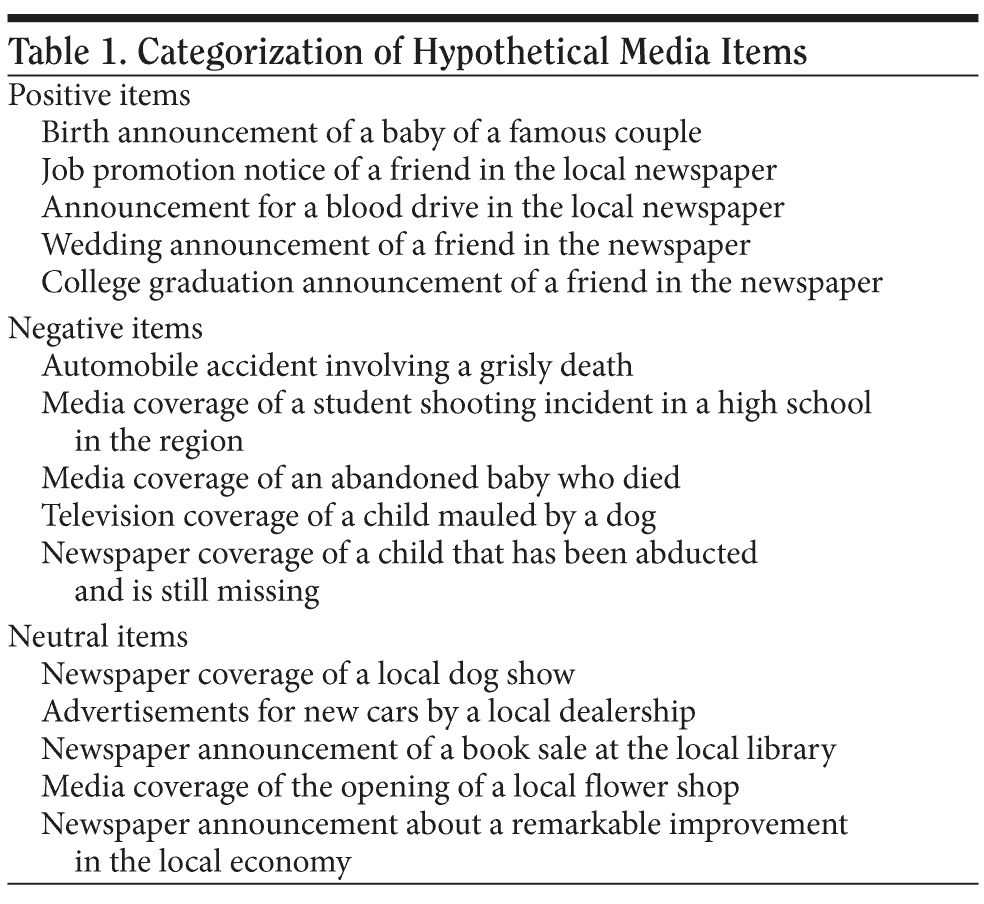Childhood Trauma and Emotional Reactivity to Hypothetical Media Events: A Pilot Study
To the Editor: Early adverse events in childhood, including abuse, may be associated with hypothalamic-pituitary-adrenal axis hyperresponsiveness1,2 as well as emotional and psychophysiologic reactivity3-5 (eg, hyperreactivity with the observation of negative images6). Indeed, emotional hyperreactivity is one of the potential findings in bona fide posttraumatic stress disorder (PTSD).7 In this study, we examined emotional responses to positive, negative, and neutral forms of hypothetical media events as a function of history of childhood trauma.
Method. Participants were male and female outpatients, aged 18 or older, being seen for outpatient medical care by residents in internal medicine. Exclusion criteria were cognitive (eg, dementia), medical (eg, pain), or intellectual impairment that would preclude the successful completion of a survey booklet. Respondents (N = 70) consisted of 18 men and 52 women, ranging in age from 18 to 84 years (mean = 41.31, SD = 15.46). Most participants were white (91.4%, n = 64), with 3 being African American, 2 hispanic, and 1 Native American. Only 11.4% (n = 8) had not graduated from high school; 54.3% (n = 38) had earned a high school diploma, 15.7% (n = 11) had completed some college coursework but not a degree, 11.4% (n = 8) had earned an undergraduate degree, and 7.1% (n = 5) had earned a graduate degree.
During the appointment, patients were invited into the project as time allowed (ie, a sample of convenience). Participants completed a 6-page research booklet that explored demographic information and emotional reactions to 21 author-developed hypothetical media events. Each item was assessed by the respondent as negative or positive. Then, using a 5-point Likert-style scale, respondents were asked to rate the intensity of their emotional reaction to each event from “very minimal” to “very strong.” Finally, with yes/no response options, participants were asked about any childhood history (ie, before age 12) of sexual, physical, or emotional abuse; the witnessing of violence; and/or physical neglect. Each form of abuse was followed by a brief explanation or definition.
Results. To create scales for the media items corresponding to positive, negative, and neutral forms of media events, respondents’ ratings were subjected to factor analysis. Based on these results, as well as examination of scale reliabilities with and without potential items, 3 such scales were constructed (ie, positive items, negative items, and neutral items), each comprising 5 items (see Table 1).
The positive items (1, 3, 5, 6, 14) demonstrated an internal consistency coefficient (α) of .85, and each item was rated as positive by 83%-92% of respondents. The negative items (2, 7, 13, 15, 21) demonstrated an internal consistency coefficient (α) of .94, and each item was rated as negative by 67%-80% of respondents. The neutral items (9, 10, 12, 19, 20) demonstrated an internal consistency coefficient (α) of .84, and each item was rated as positive by 59%-86% of respondents.
We next calculated the correlations between the number of different forms of childhood trauma experienced and ratings of the intensity of emotional reactions to positive (r = 0.16, P < .24), negative (r = 0.24, P < .08), and neutral (r = 0.37, P < .01) media events. The mean rating of the neutral items by participants with no childhood trauma was 1.68, whereas it was 2.34 for those with at least one form of childhood trauma. Note that while the absolute differences are relatively small in magnitude from a clinical perspective, they provide some modest sense of subtle between-group differences.
These findings support the current literature by indicating that traumatized individuals may display hyperreactive responses to environmental stimuli. However, a novel finding is that participants demonstrated overreactivity only to neutral or possibly ambiguous events. Previous literature indicates a likely overreactivity to negative events, as in PTSD. Perhaps less traumatized individuals show different patterns of reactivity (eg, hyperresponses to ambiguous stimuli), which is potentially relevant for clinicians working in the field of trauma.
The limitations of this study include the small sample size, the self-report nature of the data, and the use of a nonstandardized assessment of childhood trauma. However, these are unexpected and novel findings, and they provide some potential direction for the clinician in terms of symptom inquiry and treatment.
References
1. Heim C, Newport DJ, Wagner D, et al. The role of early adverse experience and adulthood stress in the prediction of neuroendocrine stress reactivity in women: a multiple regression analysis. Depress Anxiety. 2002;15(3):117-125. PubMed doi:10.1002/da.10015
2. Videlock EJ, Adeyemo M, Licudine A, et al. Childhood trauma is associated with hypothalamic-pituitary-adrenal axis responsiveness in irritable bowel syndrome. Gastroenterology. 2009;137(6):1954-1962. PubMed doi:10.1053/j.gastro.2009.08.058
3. Pole N, Neylan TC, Otte C, et al. Associations between childhood trauma and emotion-modulated psychophysiological responses to startling sounds: a study of police cadets. J Abnorm Psychol. 2007;116(2):352-361. PubMed doi:10.1037/0021-843X.116.2.352
4. Glaser JP, van Os J, Portegijs PJ, et al. Childhood trauma and emotional reactivity to daily life stress in adult frequent attenders of general practitioners. J Psychosom Res. 2006;61(2):229-236. PubMed doi:10.1016/j.jpsychores.2006.04.014
5. Jovanovic T, Blanding NQ, Norrholm SD, et al. Childhood abuse is associated with increased startle reactivity in adulthood. Depress Anxiety. 2009;26(11):1018-1026. PubMed doi:10.1002/da.20599
6. McDonagh-Coyle A, McHugo GJ, Friedman MJ, et al. Psychophysiological reactivity in female sexual abuse survivors. J Trauma Stress. 2001;14(4):667-683. PubMed doi:10.1023/A:1013081803429
7. van der Kolk BA, Saporta J. The biological response to psychic trauma: mechanisms and treatment of intrusion and numbing. Anxiety Res. 1991;4:199-212.
Author affiliations: Department of Psychiatry and Internal Medicine, Wright State University School of Medicine; Department of Psychiatry Education, Kettering Medical Center, Dayton; and Sycamore Primary Care Center, Miamisburg, Ohio (Dr Sansone); Department of Human Relations, Columbia College, Columbia, South Carolina (Dr Wiederman); and Department of Internal Medicine, Kettering Medical Center, Dayton, Ohio (Drs Hatic and Flath).
Potential conflicts of interest: None reported.
Funding/support: There was no external funding for this project.
Published online: July 8, 2010 (doi:10.4088/PCC.09l00898blu).
Prim Care Companion J Clin Psychiatry 2010;12(4):e1-e2
© Copyright 2010 Physicians Postgraduate Press, Inc.




